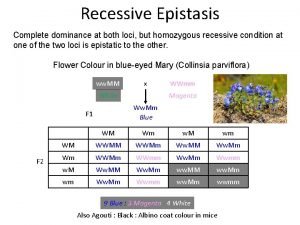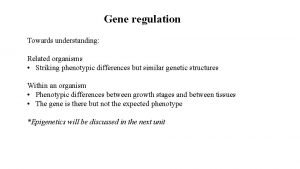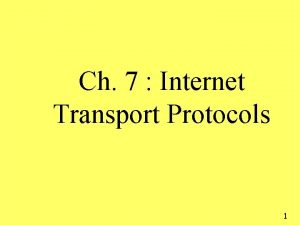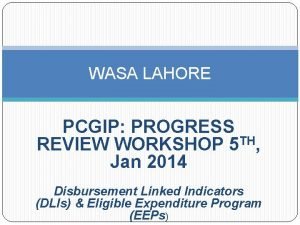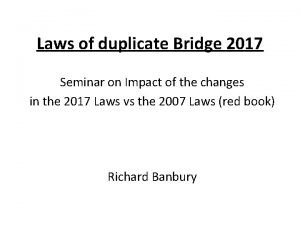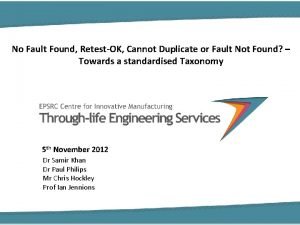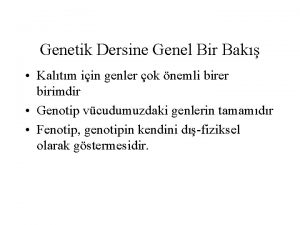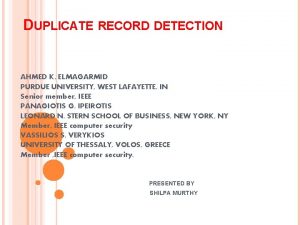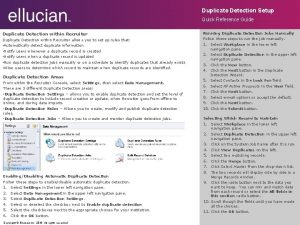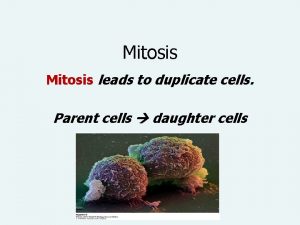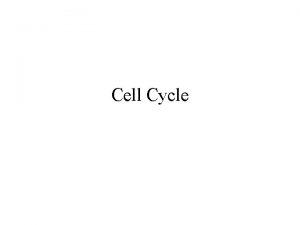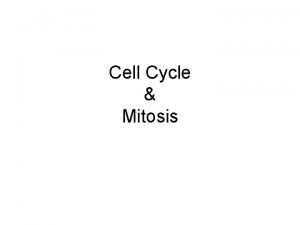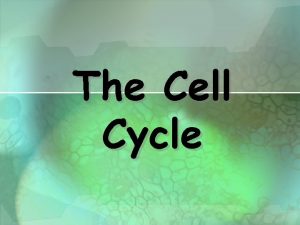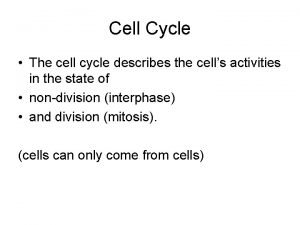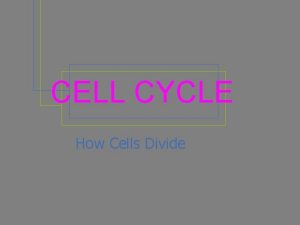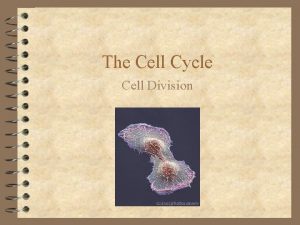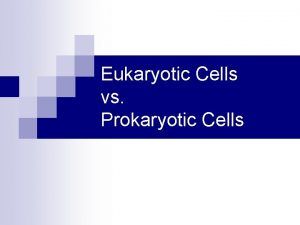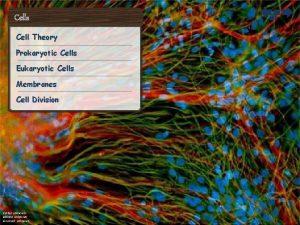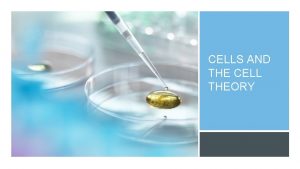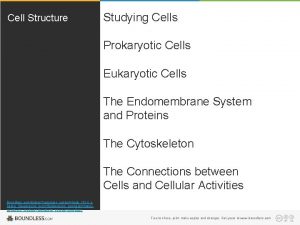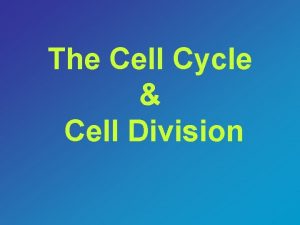Cell Cycle Checkpo The cell cycle cells duplicate































- Slides: 31

Cell Cycle Checkpo

The cell cycle: cells duplicate their contents and divide

The cell cycle may be divided into 4 phases

The cell cycle triggers essential processes (DNA replication, mitosis)

Cell Cycle Checkpoints

Progression of the cell cycle is regulated by feedback from intracellular events

Major Checkpoint Monitoring Molecules • • • Cyclins Cyclin Dependent Kinases (CDKs) p 53 - DNA damage RB - Retinoblastoma APC - Anaphase Promotin Complex

Cyclin-dependent protein kinases drive progression through the cell cycle • Cyclin-dependent kinases (Cdks) are inactive unless bound to cyclins • Active complex phosphorylates downstream targets • Cyclin helps to direct Cdks to the target proteins

Cellular levels of (mitotic) M-cyclin rises and falls during the cell cycle • M-cyclin levels are low during interphase but gradually increases to a peak level during mitosis • M-cdk activity is, likewise, low in interphase but increases in mitosis

The abundance of cyclins (and the activity of Cdks) is regulated by protein degradation • M-cyclin becomes covalently modified by addition of multiple copies of ubiquitin at the end of mitosis • Ubiqutination is mediated by the anaphase promoting complex (APC) • Ubiquitination marks cyclins for destruction by large proteolytic machines called proteasome

Cdks are also regulated by cycles of phosphorylation and dephosphorylation

Cdk activates itself indirectly via a positive feedback loop

Distinct cyclins partner with distinct Cdks to trigger different events of the cell cycle

S-Cdk triggers DNA replication - its destruction ensures this happens once per cell cycle

Checkpoints ensure the cell cycle proceeds without errors

Checkpoint: DNA damage arrests the cell cycle in G 1

Checkpoint: spindle assembly • Mitosis must not complete unless all the chromosomes are attached to the mitotic spindle • Mitotic checkpoint delays metaphase to anaphase transition until all chromosomes are attached • Prolonged activation of the checkpoint -->cell death • Mechanism of many anti-cancer drugs

Cells can withdraw from the cell cycle and dismantle the regulatory machinery • G 0 is a quiescent state • Cdks and cyclins disappear • Some cells enter G 0 temporarily and divide infrequenty (I. e. hepatocytes) • Other differentiated cell types (neurons) spend their life in G 0

p 53 Anti-tumorigenic • p 53 suppresses cell replication and growth when there is DNA damage. • Impact of less that diploid complement of p 53.

p 53 Activity

Outcome of p 53 Activation • Halts cell cycle until repair is completed. • Launches cell into apoptosis (programmed cell death).

Loss of RB – Enables continuous DNA synthesis – Defects in p 16, cyclin D, Cdk 4 have same result – Found in melanoma and liposarcoma

Anaphase Promoting Complex (APC)

Checkpoint Failure

Cancer • Normal cell division: – Controlled by cell cycle checkpoints • CHECKPOINTS – critical control points that determine if a cell will move to the next portion of the cell cycle. • Cancerous cell division: – Ignores the cell cycle checkpoints • Caused by DNA mutations • Cells grow and divide out of control • Cancerous cells do not perform designated purpose. • Crowd out normal cells that do perform designated purpose.

Cell Cycle Checkpoints • G 1/S – Monitors cell size and for DNA damage • G 2/M – Replication complete, DNA damage? • M – Spindle fibers connected, etc. ? • G 0 – Does body require more of my type of cell?

Control of cell division continued: Density Dependent Inhibition: Normal cells cease dividing once critical cell density is reached. Cancer cells do not possess this trait.

Cancer is a disease of the cell cycle. Some of the body’s cells divide uncontrollably and tumors form. Tumor in Colon Tumors in Liver

While normal cells will stop dividing if there is a mutation in the DNA, cancer cells will continue to divide with mutation.

Due to DNA mutations, cancer cells ignore the chemical signals that start and stop the cell cycle. They don’t communicate with neighboring cells and continue to grow and form tumors.

 During interphase a cell grows duplicate organelles and
During interphase a cell grows duplicate organelles and Pns water view position
Pns water view position Principal cells vs intercalated cells
Principal cells vs intercalated cells Thyroid gland
Thyroid gland How are mitosis and meiosis similar
How are mitosis and meiosis similar Somatic cells vs germ cells
Somatic cells vs germ cells Chlorocruorin
Chlorocruorin Eukaryota
Eukaryota Similarities between plant and animal cells venn diagram
Similarities between plant and animal cells venn diagram Prokaryotic vs eukaryotic cells venn diagram
Prokaryotic vs eukaryotic cells venn diagram Cell organelle jeopardy
Cell organelle jeopardy Masses of cells form and steal nutrients from healthy cells
Masses of cells form and steal nutrients from healthy cells Younger cells cuboidal older cells flattened
Younger cells cuboidal older cells flattened Prokaryotic cells vs eukaryotic cells
Prokaryotic cells vs eukaryotic cells Staphylococcus aureus prokaryotic or eukaryotic
Staphylococcus aureus prokaryotic or eukaryotic Nondisjunction in meiosis
Nondisjunction in meiosis Cells cells they're made of organelles meme
Cells cells they're made of organelles meme Malvidin production in primula
Malvidin production in primula Hash detector
Hash detector Duplicate dominant epistasis
Duplicate dominant epistasis Restored image in digital forensics
Restored image in digital forensics What is duplicate acknowledgement in tcp
What is duplicate acknowledgement in tcp Invoice original duplicate triplicate
Invoice original duplicate triplicate Wasa duplicate bill
Wasa duplicate bill Introduce assertion
Introduce assertion Maximo automation script duplicate record
Maximo automation script duplicate record Laws of duplicate bridge 2017
Laws of duplicate bridge 2017 Clonedigger
Clonedigger Duplicate payment detection
Duplicate payment detection Cannot duplicate failure in unit
Cannot duplicate failure in unit Is it duplicate
Is it duplicate An ahmed duplicate
An ahmed duplicate

















